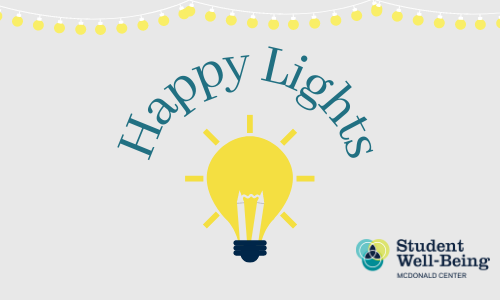Happy Lights
Winter Blues

Many students feel the effects of the South Bend "perma-cloud" as the days get shorter and sunshine is harder to come by. Otherwise known as the Winter Blues or Seasonal Affective Disorder, it is not an uncommon experience and can impact mental health and well-being.
There is a proven connection between the amount of sunlight we receive and our mental well-being. In the early 1980s, researchers discovered the innate relationship between light and seasonal depression (National Institute of Health). Students might begin to see shifts in their well-being in the Fall and Winter months, when the weather gets cooler and there are fewer hours of daylight.
Signs & Symptoms
With the change of seasons, students might recognize some of the following symptoms impacting their mental well-being:
- Feeling “down” or irritable
- Experiencing sleep problems
- Having lower energy
- Noticing fluctuations in appetite and/or weight
- Feeling unmotivated / wanting to “hibernate”
Happy Lights
“Happy Lights” are one possible solution to the “Winter Blues.” These Light Boxes are designed to emit light into the retina, thus activating the hypothalamus, the part of the brain that helps with our circadian rhythm. When our circadian rhythm is stabilized, it can help keep our seasonal symptoms in balance and reduce feeling the “Winter Blues” (Harvard Health).
Sunshine On Loan
If you think a Happy Light could be helpful for you during the Winter months, come by McWell to check one out to take home for a two week period, or use one in our Restorative Spaces! If you find the light helpful, your doctor or therapist may be able to give you a prescription that a pharmacy can fill so you can have your own light permanently.
How to check out a Happy Light:
- Come to the McWell front desk and ask to check out a Happy Light. (It is first come first served, so call ahead to check on availability.)
- You will be given an instructional form about how to use the Happy Light.
- Then sign a form of acknowledgment before checking out the Light.
- If all Happy Lights are currently checked out, your name can be added to a waitlist for the next available Happy Light.
Additional Resources
More research on Happy Lights can be found here:
https://www.nimh.nih.gov/health/publications/seasonal-affective-disorder
https://newsinhealth.nih.gov/2013/01/beat-winter-blues
https://www.mayoclinic.org/tests-procedures/light-therapy/about/pac-20384604
https://www.health.harvard.edu/blog/seasonal-affective-disorder-bring-on-the-light-201212215663